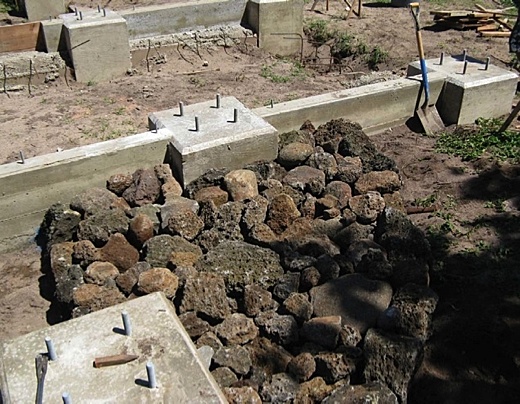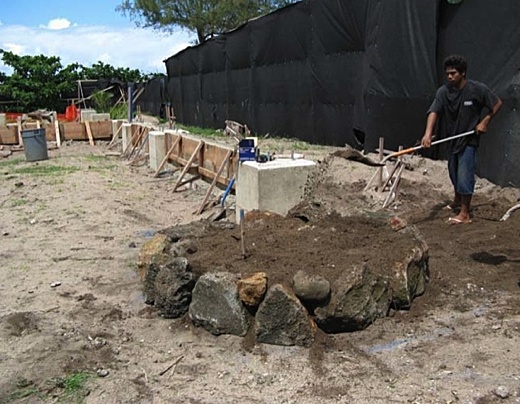 Image above: Photograph of surface protection for Burial Site #9. View to Southeast.
From figure #35 in Historic Preservation Division of the DLNR report (http://www.state.hi.us/dlnr/hpd)
[Editor's note: The document submitted by Brescia to demonstrate how to protect burial sites under and around a private house built over a graveyard indicates you should pour the column footings around the bodies or put planter boxes over them. In any case I would not sleep easily in that house.]
By Michael Levine on 13 March 2010 in Garden Island News -
(http://thegardenisland.com/news/local/article_4b763dfe-2db2-11df-a53c-001cc4c002e0.html)
The 16th iteration of a burial treatment plan (BTP) that would allow Naue landowner Joseph Brescia to move forward with construction on his single-family home atop 30 known Hawaiian burials was approved this week by the State Historic Preservation Division.
Image above: Photograph of surface protection for Burial Site #9. View to Southeast.
From figure #35 in Historic Preservation Division of the DLNR report (http://www.state.hi.us/dlnr/hpd)
[Editor's note: The document submitted by Brescia to demonstrate how to protect burial sites under and around a private house built over a graveyard indicates you should pour the column footings around the bodies or put planter boxes over them. In any case I would not sleep easily in that house.]
By Michael Levine on 13 March 2010 in Garden Island News -
(http://thegardenisland.com/news/local/article_4b763dfe-2db2-11df-a53c-001cc4c002e0.html)
The 16th iteration of a burial treatment plan (BTP) that would allow Naue landowner Joseph Brescia to move forward with construction on his single-family home atop 30 known Hawaiian burials was approved this week by the State Historic Preservation Division. Announced in a Monday letter from SHPD Administrator Pua Aiu to Dr. Mike Dega of Scientific Consultant Services and various interested parties, the decision flies in the face of a unanimous recommendation for rejection from the Kaua‘i Ni‘ihau Island Burial Council last month, sanctions the controversial house, and closes a significant chapter in the years-long fight between land rights and traditional values.
“SHPD is failing in their obligations and duties of what their jobs are. Totally, totally failing. An F-minus,” said Puanani Rogers, a Hawaiian cultural practitioner and long-time school teacher.
“It’s outrageous that they are not doing their job. Everybody knows, except them, that they’re not supposed to build on a graveyard.”
The 16th burial treatment plan is different from its 15 predecessors, Aiu said, in that it “finally” adequately addresses the provisions of Section 13-300 of the Hawai‘i Administrative Rules, which require BTPs to attempt to identify lineal descendants and weigh their concerns.
Rogers said some lineal descendants were reluctant to file paperwork claiming their status because the state Department of Land and Natural Resources, under which SHPD falls, does not have a genealogist, a decision she said hampered attempts to stop construction.
Section 13-300 also requires burial plans to put forward short-term and long-term preservation measures if burials are to be preserved in place.
“The burial council has a mission to protect burials, and to look at burials, and that’s all they have to do,” Aiu said Thursday, noting that landowners, burial councils and Native Hawaiian cultural practitioners each have their own roles to play. “I think we had the difficult position of having to balance very different rights and responsibilities on this land.”
Aiu said SHPD eventually decided that BTP No. 16 provided “adequate protection” to the 30 burials, including cement caps over a number of them and special vertical buffers for one burial that sits under the spot that will one day be the home’s driveway.
“Both the KNIBC and members of the public stated that they did not believe the placement of concrete caps over the burials was respectful and proper,” Aiu wrote in her letter to Dega.
“The SHPD however recognizes that ... there does need to be some physical or visual protective measures put in place to ensure that the burials near construction are protected and not disturbed. The concrete caps do serve this purpose.”
Thursday, Aiu said “people are going to disagree or agree with us, but we had to make sure there was adequate protection.”
Asked specifically how BTP No. 16 differed from previous versions that were rejected by SHPD, Aiu said that some complaints about unclear writing were addressed, but that there was not one specific significant change that led her division to grant the approval.
“It went through many iterations, and each time it went through, we caught something else,” she said. “I think that we’ve done the best job that we can given the circumstances. I think people think we take this decision lightly, and we don’t, but it’s part of what we have to do.”
Phone messages left Thursday afternoon seeking comment from a pair of attorneys representing Brescia and two attorneys at the Native Hawaiian Legal Corporation were not returned as of press time.
KNIBC Chair Clisson Kunane Aipoalani said he would withhold comment until after he had an opportunity to review Aiu’s letter.
 Image above: Photograph of Protective Planter in Driveway at Burial Site #30. View to Northeast
From figure #36 in Historic Preservation Division of the DLNR report (http://www.state.hi.us/dlnr/hpd)
Image above: Photograph of Protective Planter in Driveway at Burial Site #30. View to Northeast
From figure #36 in Historic Preservation Division of the DLNR report (http://www.state.hi.us/dlnr/hpd)
The Future
With the recent decision by the county Planning Commission to decline to revoke Brescia’s permits and the state’s final approval of Brescia’s home construction, the last potential venues for cultural practitioners to make their case appears to be the state Legislature or a court of law.
“We’ve got to change the laws. Something’s got to be done about that. ‘Preserve in place’ has to mean that you don’t build on top,” Rogers said. “They’re building on top of a huge graveyard. Don’t they have a law that says you can’t build on graveyards?”
Ha‘ena resident Louise Sausen said Thursday she was “surprised” and “baffled” by the government’s disregard for due process, but said she was proud of the Hawaiian community for speaking out on the issue and hopes the Brescia case can serve as a lesson for the future.
“It sets a precedent for future projects that this is not what we want to go through, let’s take care of it before it gets to this point,” Sausen said. “There’s still more battles to fight, but at least we have something to use as an example of where we want to be going, and just take it from there.”
Asked if SHPD would change anything about its procedures in light of the Brescia case when working on future applications, Aiu said she was “not sure that a different procedure would make a difference” because an archaeological inventory survey was conducted, located the known burials, leading to the burial council process that offered a choice between preserving in place and disinterring and reinterring the bones.
Because state law, upheld by judicial opinions, does not allow the burial councils to simply stop landowners from construction, any procedure put forth by SHPD would “still run up against the issue of whether a landowner can build a home on a lot like this,” Aiu said.
“Do we have the right to make a landowner not have the use of their land?” she asked. “That’s the ultimate question, and I think ultimately it will be decided in court. I hope it’s settled clearly so we have clear direction.”
For more information, visit www.state.hi.us/dlnr/hpd and click “BRESCIA BURIAL TREATMENT PLAN.”
See also: Island Breath: Ola Na Iwi - The Bones Live 6/8/08
.
No comments :
Post a Comment